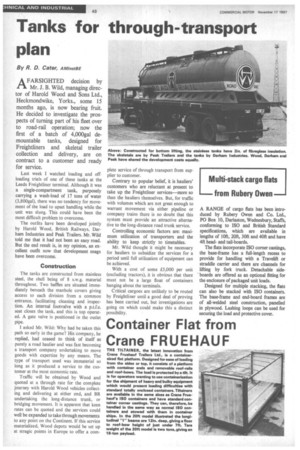Tanks for through-transport plan
Page 50

If you've noticed an error in this article please click here to report it so we can fix it.
By R. D. Cater, AMInstBE AFARSIGHTED decision by Mr. J. B. Wild, managing director of Harold Wood and Sons Ltd., Heckmondwike, Yorks., some 15 months ago, is now bearing fruit. He decided to investigate the prospects of turning part of his fleet over to road-rail operation; now the first of a batch of 4,000gal demountable tanks, designed for Freightliners and skeletal trailer collection and delivery, are on contract to a customer and ready for service.
Last week I watched loading and offloading trials of one of these tanks at the Leeds Freightliner terminal. Although it was a single-compartment tank, purposely carrying a wash-load of 17 tons of water (3,800gal), there was no tendency for movement of the load to upset handling while the unit was slung. This could have been the most difficult problem to overcome.
The outfits have been developed jointly by Harold Wood, British Railways, Darham Industries and Peak Trailers. Mr. Wild told me that it had not been an easy road. But the end result is, in my opinion, an excellent outfit now that development snags have been overcome.
Construction The tanks are constructed from stainless steel, the shell being of 8 s.w,g. material throughout. Two baffles are situated immediately beneath the manhole covers giving access to each division from a common entrance, facilitating cleaning and inspection. An internal footvalve with a p.t.f.e. seat closes the tank, and this is top operated. A gate valve is positioned in the outlet pipe
I asked Mr. Wild: Why had he taken this path so early in the game? His company, he replied, had ceased to think of itself as purely a road haulier and was fast becoming a transport company undertaking to move goods with expertize by any means. The type of transport used was immaterial so long as it produced a service to the customer at the most economic rate.
Traffic will be obtained by Wood and quoted at a through rate for the complete journey with Harold Wood vehicles collecting and delivering at either end, and BR undertaking the long-distance trunk, or bridging movement. It is apparent that keen rates can bc quoted and the services could well be expanded to take through movements to any point on the Continent. If this service materialized, Wood depots would be set up at stragic points in Europe to offer a corn
plete service of through transport from supplier to customer.
Contrary to popular belief, it is hauliers' customers who are reluctant at present to take up the Freightliner services—more so than the hauliers themselves. But, for traffic with volumes which are not great enough to warrant movement via either pipeline or company trains there is no doubt that this system must provide an attractive alternative to the long-distance road trunk service.
Controlling economic factors are: maximum utilization of transporters and the ability to keep strictly to timetables.
Mr. Wild thought it might be necessary for hauliers to subsidize the services for a period until full utilization of equipment can be achieved.
With a cost of some £5,000 per unit (excluding tractors), it is obvious that there must not be a large float of containers hanging about the terminals.
Critical cargoes are unlikely to be routed by Freightliner until a good deal of proving has been carried out, but investigations are going on which could make this a distinct possibility.
















































































































































